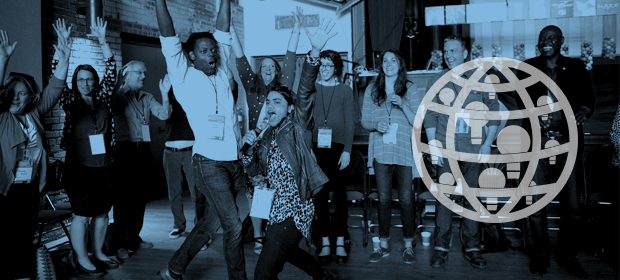Where We Work
See our interactive map



Most of the 350+ people who come to this North Carolina conference aren’t artists. That’s the point.
It’s one of the things that puzzles people most about SwitchPoint.
I mean, this is a conference about global health, technology, and humanitarian innovation, right? So what’s the deal with that guy reciting poetry? Or those modern dancers? Or the live music peppered throughout a program that’s otherwise packed with entrepreneurs and inventors and experts?
Here’s the answer.
We talk a lot in global health and academia about “breaking down silos.” We’ve said it so much that it’s become a cliché.
But the true meaning of the expression—the desire to pull people out of the deep niches they’ve nestled into so they can swap ideas and share their knowledge across disciplines—is worthwhile. It's the only way we'll make any real progress on our greatest human ambitions, such as the Sustainable Development Goals.
And this is what it looks like when you break down silos. You end up in a room with people you didn’t expect.
Most of the 350+ people who come to SwitchPoint in Saxapahaw, North Carolina, aren’t artists. They’re CEOs and students, entrepreneurs and professionals from across humanitarian fields. But this makes integrating the arts even more crucial. Because we’re not just trying to get demographers talking to epidemiologists, or educators talking to family planning experts (though that’s a good start).
If we want large-scale global change, we have to engage with culture in more meaningful ways. And nothing reflects and shapes our cultures more clearly than our arts.
For one thing, think of where we turn when we want to relax or refresh our souls. Our favorite music, familiar stories, beautiful outdoor spaces with family and friends. Those are the times when we’re most likely to open our minds to new ideas and make the personal decisions that steer us through life.
Art helps us understand each other, reach each other.
This year, as always, a key theme at SwitchPoint is artivism. We’ll see this next week not only in the live performances throughout the two-day event—including live music, performance art, large-scale puppetry, and more—but also through in-depth discussions about:
We know that getting a diverse group of hundreds of thinkers and doers together works—we’ve seen the power of the connections people make when this happens.
But I’ll be honest, it’s not always comfortable.
There have been occasional F-bombs onstage. There have been times when speakers questioned the very motives behind international development, in a room full of people who had dedicated their lives to it. And whenever an artist calls on the audience to sing along or throw things around or otherwise take part in a performance, the introvert in me longs to be needed at an urgent meeting far, far away.
It makes me squirm. It makes me stretch myself.
But if bringing together truly diverse groups were comfortable, we wouldn’t still be struggling to make it happen in our neighborhoods and industries around the world.
Art reveals the best and the worst of humanity. It helps us understand each other, reach each other. And as humanitarians, we should remember that behind all our data and frameworks and acronyms, we are simply human beings reaching out to other human beings.
Get the latest updates from the blog and eNews




